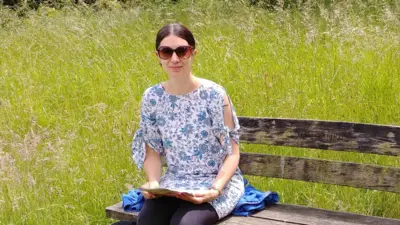We've updated our Privacy and Cookies Policy
We've made some important changes to our Privacy and Cookies Policy and we want you to know what this means for you and your data.
How buzzards came to fly over the UK again
- By Justin Parkinson
- BBC News Magazine
Image source, Thinkstock
Buzzards were once almost hunted out of existence but they've made a huge comeback, with numbers soaring in the past few years.
It's currently breeding time for common buzzards. Around the UK, males can be seen performing aerial displays as they try to impress females and warn off rivals. They rise and drop rapidly, in a manoeuvre known as the "rollercoaster", and complete loop-the-loops.
They make a mewing sound like a cat and like to rest on fence posts and pylons. Once they find mates, they stay together for life.
In the early 1900s, killed off by gamekeepers frightened they would destroy their pheasants and grouse, there were as few as 1,000 breeding pairs in the UK. Nowadays there are up to 68,000. Common buzzards - also known as Eurasian buzzards or by their Latin name Buteo buteo - are known to have bred in Glasgow, Edinburgh and Nottingham.
Image source, Thinkstock
"The shows they put on are really quite spectacular," says Jeff Knott, species policy officer for the Royal Society for the Protection of Birds. "The degree of danger in the aerobatics depends on how easy or difficult the female is to impress. Some of them get really near the ground when they're doing the rollercoaster."
The buzzard is sometimes known as the "tourist eagle" because people commonly mistake it for its larger fellow raptor (or bird of prey).
Its main prey is small mammals, including voles, mice, rats, moles, rabbits and hares, but it can live on worms and insects when these are scarce. Buzzards also search for carrion (dead meat), such as road kill, the reason drivers see them hovering over roads and motorways.
They've been known to take bones from rubbish tips, allowing them to live in or on the outskirts of cities. But, unlike seagulls, who can eat chips, bread and pasties, buzzards need to consume flesh, so are unlikely to be found rummaging in dustbins.
Between March and May, breeding pairs, the displays over, build nests near the edges of woods.
"They are striking," says Sean Walls, avian segment manager at the animal-monitoring company Biotrack. "But to many people they don't have the rarity or magnificence of some birds of prey, so they don't get the attention of, say, a golden eagle."
But they have come under threat. Culling by gamekeepers meant that, by 1875, buzzards were only to be found in western parts of Britain, the population reaching a nadir by the start of the 20th Century. Restrictions placed on illegal killing during the two world wars allowed numbers to recover.
Buzzard facts
- Common buzzards normally live for around 12 years, although the maximum recorded lifespan is 28 years and nine months
- Wingspans can be as long as 60ins (152cm)
- In the UK, they are found in greatest numbers in Scotland, Wales, the Lake District and south-west England,
- They live across all of Europe, excluding Iceland and the northern Scandinavia, large areas of Asia and Africa
- Females have larger talons and beaks than those of males
But the spread of the myxomatosis virus to the UK in 1953 is estimated to have killed more than 99% of the country's rabbits, removing much of the buzzard's food supply. And the use of organochlorine pesticides in the 1950s and 1960s affected its reproductive capacity. The population is thought to have been about 10,000 breeding pairs by the mid-1960s.
Since then things have improved, with numbers increasing sharply by the 1990s. The Countryside Alliance found there were 68,000 breeding pairs of buzzards in Britain in 2013 - almost double the number in 2006 and more than four times the number in 1997.
Since the year 2000 every county in England is known to have hosted buzzards. When non-breeding birds - those too young to procreate - are added to the breeding pairs, it's estimated there are up to 300,000 in total in the UK.
Image source, Thinkstock
The buzzard is now at little or no risk of becoming endangered in the UK, in contrast to some other birds of prey, such as the hen harrier and the white-tailed eagle.
"The critical thing is reduced persecution," says Walls. "Buzzards are not as big a threat to pheasants or grouse as some birds, such as the goshawk. They will take a few birds but not as many, and many gamekeepers have come to realise that."
But the Countryside Alliance has raised concerns that the "population is becoming unsustainable, and in some instances is having an adverse impact on other wildlife".
"There's been an incredible reverse in their decline, which is fantastic," says Liam Stokes, the organisation's head of shooting. But there needs to be more flexibility where there are "local issues" involving excessive numbers, he adds.
Gamekeepers have complained that the growth in population has put their livelihoods at risk, with too many pheasants and grouse being killed.
The Wildlife and Countryside Act 1981 makes it illegal to kill, injure or take a wild bird, but people can apply for licences to do so - one possible reason being that there is a serious danger to livestock or crops.
A gamekeeper from Berwick was repeatedly refused a licence to trap and kill buzzards, which he said were taking his baby pheasants.
In November last year, the High Court ruled that Natural England, the body advising the government on preserving the environment, had acted "inconsistently" in not granting any licences for buzzards to be trapped and killed but allowing them for other species.
It had "unlawfully operated an undisclosed policy about how buzzard populations were to be treated", requiring "far higher quality evidence" than other birds. "The substantial reason for the difference in approach was some hostile public opinion."
Natural England said: "Whilst we are disappointed at the outcome, we welcome the court's clarification on the legal framework."
Image source, Thinkstock
There is still illegal killing of buzzards going on, says Knott, but he estimates the population will increase by about another 10%, growing particularly strongly in the eastern areas where they still have room to breed more freely.
"In the next few years, almost every person in England should be able to see a buzzard near where they live with a minimum of difficulty," he says. "When I was a boy we used to drive on holidays from Kent to Cornwall and we used to think we were nearing our destination when we saw a buzzard over the motorway. Now, not that much later, they're all over the country. That's an incredible story."
Image source, Thinkstock
More from the Magazine
Image source, Getty Images
The last wolf in the UK was shot centuries ago, but now a "rewilding" process could see them return to Scotland. Adam Weymouth hiked across the Scottish Highlands in the footsteps of this lost species.
Follow Justin Parkinson on Twitter @justparkinson
Subscribe to the BBC News Magazine's email newsletter to get articles sent to your inbox.
Top Stories
Features & Analysis
Most read
Content is not available








